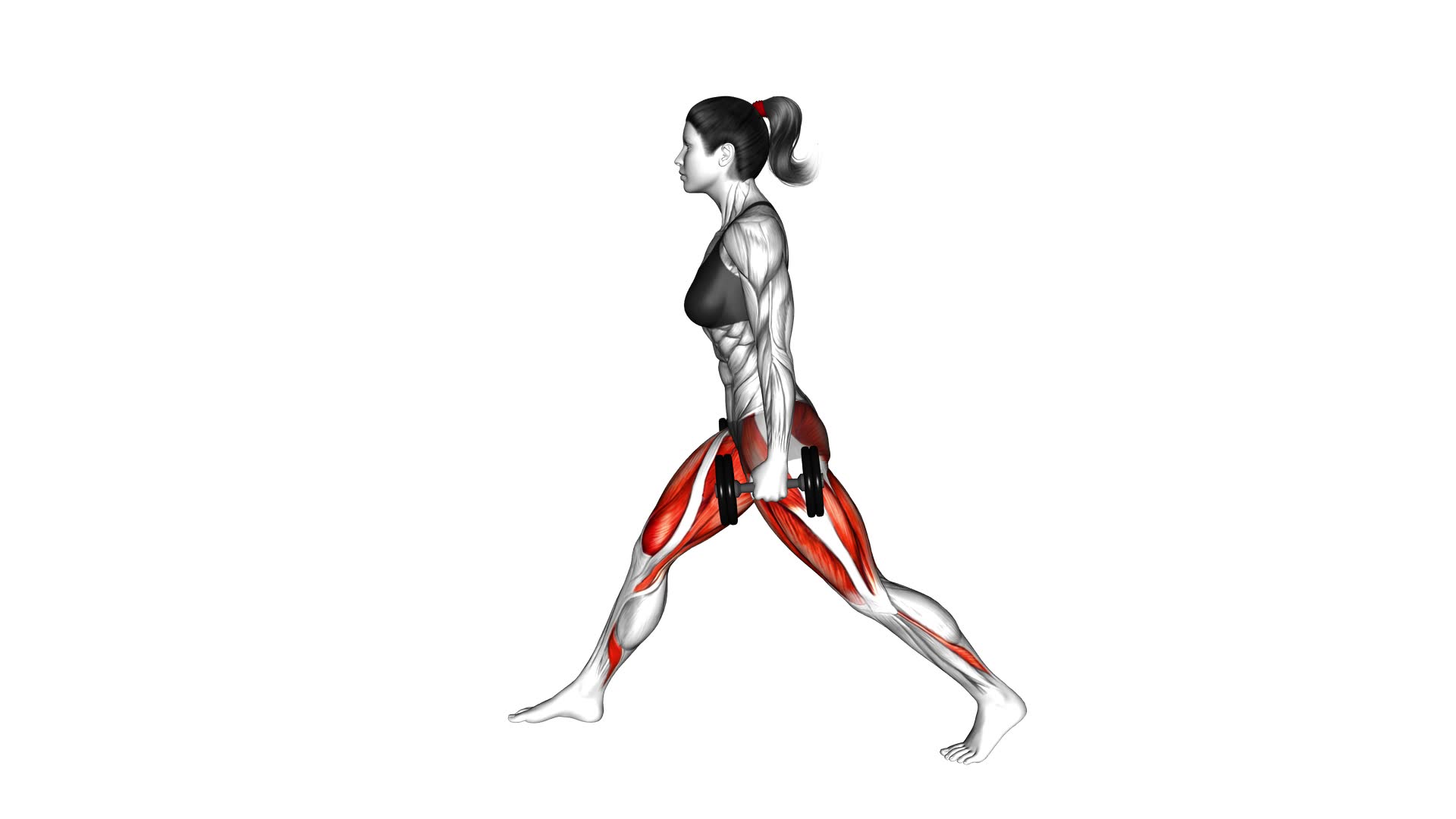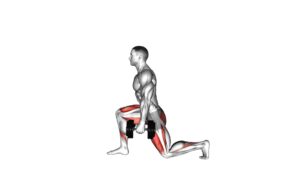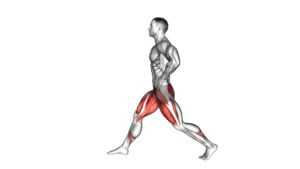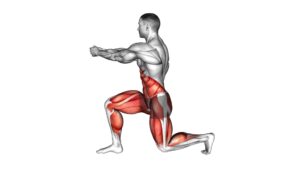Dumbbell Static Lunge (female) – Video Exercise Guide & Tips

Are you looking for a challenging lower body exercise that targets multiple muscles at once? Look no further than the dumbbell static lunge!
Watch This Exercise Video
This exercise is perfect for women who want to strengthen their legs and glutes.
In this video exercise guide, you'll learn the proper form, modifications for beginners, advanced variations, common mistakes to avoid, and tips for incorporating the dumbbell static lunge into your workout routine.
Let's get started and take your leg day to the next level!
Key Takeaways
- Proper form techniques and weight selection are important for engaging core muscles, maintaining stability, and avoiding injury.
- Beginners can start with bodyweight lunges, use a chair for support, take smaller steps, or perform reverse lunges to modify the exercise.
- The dumbbell static lunge strengthens leg muscles, improves balance and stability, engages core muscles, targets glutes and hamstrings, and enhances functional movement.
- To incorporate the dumbbell static lunge, focus on proper form techniques, include it in your workout routine, select appropriate weight, gradually increase difficulty, and track progress.
Benefits of the Dumbbell Static Lunge
The benefits of performing the Dumbbell Static Lunge are numerous. The exercise targets multiple muscle groups simultaneously, including the quadriceps, hamstrings, and glutes. This helps to strengthen and tone these muscles. Additionally, the exercise engages the core and stabilizer muscles, improving balance and stability.
One advantage of the Dumbbell Static Lunge is its versatility. It allows for various variations, such as different foot positions (narrow or wide stance) to emphasize specific muscle groups. You can also modify the exercise by using different dumbbell weights or holding the dumbbells in different positions.
Proper Form for the Dumbbell Static Lunge
When performing the dumbbell static lunge, proper foot placement is crucial for stability and balance. You should focus on keeping your front foot flat on the ground, with your knee directly above your ankle.
Additionally, engaging your core throughout the exercise will help maintain proper form and prevent injury.
Foot Placement Importance
To achieve proper form for the Dumbbell Static Lunge, focus on positioning your feet correctly. Proper foot placement is essential for maintaining stability and maximizing the effectiveness of this exercise. Here are some foot placement techniques to ensure proper alignment:
- Start by standing with your feet hip-width apart.
- Take a step forward with one leg, keeping your heel on the ground and your toes pointing forward.
- Bend both knees to lower your body down into a lunge position.
- Make sure your front knee is directly above your ankle, forming a 90-degree angle.
- Keep your back foot stable, with the heel lifted.
By following these foot placement techniques, you'll engage the correct muscles and reduce the risk of injury.
Now, let's move on to the next section about core engagement techniques.
Core Engagement Techniques
Engage your core muscles to maintain stability and proper form during the Dumbbell Static Lunge. Core activation is essential for maintaining balance and preventing injury during this exercise.
As you perform the lunge, focus on tightening your abdominal muscles, as well as your lower back and hips. This will help to stabilize your body and keep your torso upright. By engaging your core, you ensure that the load is evenly distributed throughout your body, reducing strain on your joints and increasing the effectiveness of the exercise.
It's also important to note that there are different lunge variations that can further engage your core muscles, such as the walking lunge or the overhead lunge. Experiment with these variations to challenge your core even more.
How to Modify the Dumbbell Static Lunge for Beginners
For beginners, it's important to start with lighter weights when modifying the Dumbbell Static Lunge. This will allow you to focus on your form and gradually build strength and endurance. Here are some modifications and progressions that can help you get started:
- Begin with bodyweight lunges: Start by performing the static lunge without any weights. This will help you practice the correct form and engage the muscles effectively.
- Use a lighter dumbbell: Instead of using heavy dumbbells, start with a lighter weight that you can comfortably handle. This will reduce the strain on your muscles and joints as you develop proper technique.
- Increase the range of motion: As you become more comfortable with the exercise, you can gradually increase the depth of your lunge. This will challenge your muscles more and help you progress.
- Perform split squats: If the static lunge feels too challenging, you can try doing split squats instead. This variation allows you to focus on one leg at a time, making it easier to maintain balance and control.
- Incorporate balance aids: If you struggle with balance, you can use a wall, chair, or stability ball for support. This will help you maintain stability and prevent injuries as you work on your lunges.
Advanced Variations of the Dumbbell Static Lunge
Are you ready to take your Dumbbell Static Lunge to the next level with advanced variations? If you're looking to challenge yourself and continue progressing in your fitness journey, incorporating advanced modifications and plyometric variations into your Dumbbell Static Lunge routine can be highly effective.
One advanced modification you can try is the Bulgarian Split Squat. This variation requires you to elevate your back foot on a platform or bench, increasing the range of motion and placing more emphasis on your front leg. By doing so, you'll engage your glutes, quadriceps, and hamstrings even more.
Another advanced option is the Jumping Lunge. This plyometric variation adds a cardiovascular element to your workout and helps improve explosive power. Start by performing a regular Dumbbell Static Lunge, but as you come up from the lunge position, jump explosively and switch legs mid-air. Land softly and immediately go into the next repetition.
By incorporating these advanced modifications and plyometric variations, you can challenge your muscles in new ways, improve your strength, and enhance your overall fitness level.
Now, let's discuss some common mistakes to avoid during the Dumbbell Static Lunge to ensure you're getting the most out of your workout.
Common Mistakes to Avoid During the Dumbbell Static Lunge
To maximize the effectiveness of your Dumbbell Static Lunge, it's important to avoid these common mistakes:
- Leaning Forward: One of the most common mistakes is leaning forward during the lunge. This not only puts excessive strain on your knees but also reduces the activation of your glutes and hamstrings. Remember to keep your torso upright throughout the exercise.
- Not Lunging Deep Enough: Another mistake isn't lunging deep enough. To fully engage your leg muscles, you should aim to lower your back knee until it's just above the ground. This ensures that you're getting the most out of the exercise.
- Allowing Your Knee to Cave In: Allowing your knee to cave inwards is a common mistake that can lead to knee pain and instability. Be sure to keep your knee aligned with your toes throughout the lunge to prevent any unnecessary strain.
- Using Too Much Weight: Using excessive weight can compromise your form and increase the risk of injury. Start with lighter dumbbells and gradually increase the weight as you become more comfortable with the exercise.
- Neglecting the Core: Many people tend to neglect their core muscles during the lunge. Engaging your core helps stabilize your body and maintain proper form. Remember to keep your abs tight and your spine neutral throughout the movement.
Tips for Incorporating the Dumbbell Static Lunge Into Your Workout Routine
To effectively incorporate the dumbbell static lunge into your workout routine, it's important to focus on proper form techniques. This includes maintaining a straight back, engaging your core, and keeping your knees in line with your toes.
Additionally, selecting the appropriate weight is crucial to ensure that you're challenging yourself without compromising your form.
Proper Form Techniques
When incorporating the Dumbbell Static Lunge into your workout routine, focus on maintaining proper form throughout the exercise. Here are some tips to help you achieve optimal results:
- Engage your core for stability: Keep your abdominal muscles tight and your back straight to ensure proper alignment and prevent injury.
- Step forward with control: Take a controlled step forward, keeping your front knee aligned with your ankle and your back knee hovering just above the ground.
- Keep your weight in your front heel: This will help activate your glutes and hamstrings while maintaining balance.
- Breathe properly: Inhale as you lower your body down and exhale as you push back up to the starting position. This will provide oxygen to your muscles and help you maintain control.
- Use an appropriate weight: Start with lighter dumbbells and gradually increase the weight as you become more comfortable with the exercise.
Weight Selection Guidelines
To effectively incorporate the Dumbbell Static Lunge into your workout routine, it's essential to select an appropriate weight that challenges your muscles without compromising your form or risking injury. The weight selection plays a crucial role in maximizing muscle activation during the exercise. Choosing a weight that's too light may not provide enough resistance to stimulate muscle growth, while selecting a weight that's too heavy can lead to poor form and potential injuries.
To determine the right weight for you, start with a weight that allows you to perform the exercise with proper form for the desired number of repetitions. You should feel the muscles in your legs working, but you should still be able to maintain control throughout the movement. Gradually increase the weight as your strength and form improve.
Now that you understand the importance of weight selection, let's move on to discussing variations of the Dumbbell Static Lunge that are suitable for beginners.
Variations for Beginners
To incorporate the Dumbbell Static Lunge into your workout routine as a beginner, try using a lighter weight and focusing on maintaining proper form and control throughout the movement.
Here are some variations and modifications for less experienced individuals:
- Start with bodyweight lunges: Begin by performing the exercise without any added weight to get comfortable with the movement.
- Use a chair for support: If balance is a challenge, place a chair next to you and lightly hold onto it for stability.
- Take smaller steps: Instead of lunging with a large step forward, try taking smaller steps to reduce the intensity.
- Perform reverse lunges: Instead of stepping forward, step backward into the lunge position. This can be easier on the knees.
- Limit the range of motion: If you find it difficult to go all the way down into a deep lunge, reduce the range of motion and only go as far as is comfortable for you.
Frequently Asked Questions
How Many Sets and Reps Should I Do for the Dumbbell Static Lunge?
To determine the number of sets and reps for the dumbbell static lunge, consider your fitness goals and current abilities. Start with 2-3 sets of 8-12 reps per leg, using a weight that challenges you but allows for proper form.
As you progress, you can increase the number of sets or reps or even try variations of the dumbbell static lunge, such as adding a pulse at the bottom or performing it on an elevated surface.
Always listen to your body and adjust accordingly.
Can I Do the Dumbbell Static Lunge Without Weights?
Yes, you can do the dumbbell static lunge without weights. This exercise is also effective without the added resistance. By performing the movement without weights, you can focus on your form and stability. It's a great alternative for beginners or those who may not have access to dumbbells.
The benefits of the dumbbell static lunge include strengthening your legs, glutes, and core muscles, improving balance, and increasing overall lower body strength.
Is the Dumbbell Static Lunge Suitable for People With Knee or Hip Issues?
If you have knee or hip issues, the dumbbell static lunge may not be suitable for you. It's important to listen to your body and find alternatives that won't aggravate your condition.
Instead of the dumbbell static lunge, you can try other exercises like step-ups or glute bridges, which put less stress on the knees and hips.
Don't hesitate to modify or adapt exercises to meet your individual needs and protect your joints.
How Often Should I Perform the Dumbbell Static Lunge in My Workout Routine?
To determine how often to do the dumbbell static lunge in your workout routine, consider your fitness goals and overall program. It's recommended to include this exercise 2-3 times a week for strength and muscle development.
However, it's important to listen to your body and adjust accordingly.
To add variation to your routine, you can try different types of lunges, such as walking lunges or reverse lunges, to target different muscle groups and keep your workouts challenging.
Can I Incorporate Other Exercises With the Dumbbell Static Lunge for a Full Lower Body Workout?
Yes, you can definitely incorporate other exercises with the dumbbell static lunge for a full lower body workout.
By adding variations of the dumbbell static lunge, such as the walking lunge or the reverse lunge, you can target different muscles and challenge your body in new ways.
The benefits of the dumbbell static lunge include increasing lower body strength, improving balance, and enhancing stability.
Conclusion
In conclusion, the dumbbell static lunge is a highly effective exercise for strengthening and toning the lower body. It offers numerous benefits, including improved balance, increased muscle strength, and enhanced flexibility.
By maintaining proper form and avoiding common mistakes, you can maximize the benefits of this exercise. Whether you're a beginner or advanced, there are modifications and variations available to suit your fitness level.
Incorporate the dumbbell static lunge into your workout routine to achieve stronger and more sculpted legs.

Author
Years ago, the spark of my life’s passion ignited in my mind the moment I stepped into the local gym for the first time. The inaugural bead of perspiration, the initial endeavor, the very first surge of endorphins, and a sense of pride that washed over me post-workout marked the beginning of my deep-seated interest in strength sports, fitness, and sports nutrition. This very curiosity blossomed rapidly into a profound fascination, propelling me to earn a Master’s degree in Physical Education from the Academy of Physical Education in Krakow, followed by a Sports Manager diploma from the Jagiellonian University. My journey of growth led me to gain more specialized qualifications, such as being a certified personal trainer with a focus on sports dietetics, a lifeguard, and an instructor for wellness and corrective gymnastics. Theoretical knowledge paired seamlessly with practical experience, reinforcing my belief that the transformation of individuals under my guidance was also a reflection of my personal growth. This belief holds true even today. Each day, I strive to push the boundaries and explore new realms. These realms gently elevate me to greater heights. The unique combination of passion for my field and the continuous quest for growth fuels my drive to break new ground.







